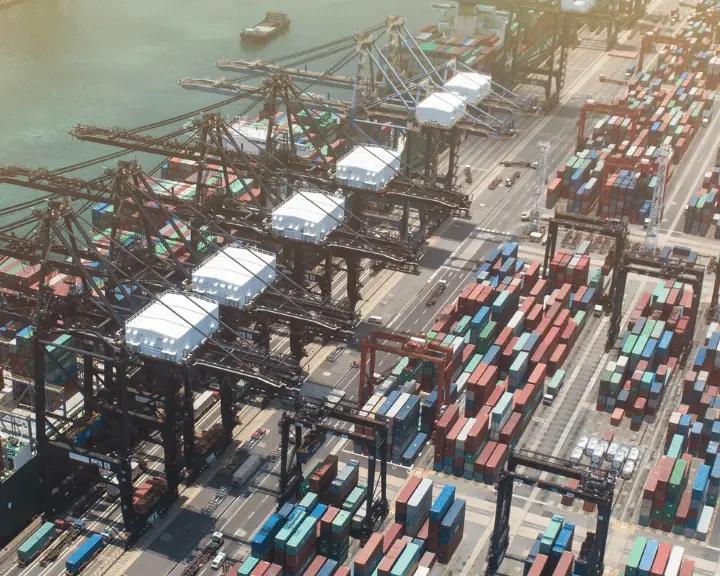Supply chain digitization prepares your company for resilient growth at any pace, and helps you seize opportunities to scale your business, whether you’re processing ten transactions a day or 10 million.
Supply Chain Trends
As we’ve seen in the wake of COVID-19, the supply chain and proper management of it can impact the fabric of society as we know it.
Supply chain trends in 2021 saw 66% of supply chain respondents report “some or major” supply chain disruptions. In the wake of the pandemic and with the trends that supply chain specialists saw in 2021, everyone is wondering about the future of supply chain logistics and how disasters can be avoided.
Supply chain trends are noticed or frequent patterns within the supply chain. Actions do not occur in a vacuum, and certain trends could seriously impact the future of the supply chain and the ability to get products from Point A to Point Z effectively.
In 2021, many supply chain managers reported moderate or significant disruptions at multiple stages in the supply chain process, from production delays to outbound logistics issues. The largest significant disruption reported was at 31% due to out-of-stock products that resulted from spikes in demand. In addition, these significant disruptions in many different sectors of the supply chain have led to delayed recovery.
The Association for Supply Chain Management reported that the way to prepare for significant disruptions is to have a solid supply chain risk management strategy. The future of digital supply chain management will likely involve a heavy focus on mitigating risk from supply chain disruptions. Digital supply chain management can allow for increased product visibility, better reporting, and the ability to know sooner than ever when something might be late. The future of supply chain, Freight Waves contends, should not fear digitization. Chain.io works with supply chain management software to create integrations that enable the faster and better transfer of data.
Trends can be a great predictor of the future of the supply chain and the ripple effects to be caused by the employees and society as a whole. Trends can also be a great indicator of change. If a trend is identifying a problem point within supply chain management, it may highlight a process that will soon need to adapt to relieve pressure and improve the flow of the supply chain.
Supply Chain Trends 2022
As far as this year’s supply chain trends, 2022 saw an increased focus on resiliency and recovery from the pandemic. Supply chain visibility has seen a huge uptick in importance as a result of the disruptions caused by the pandemic. A few of the biggest supply chain management trends 2022 has seen thus far are the implementation of artificial intelligence, an ‘internet of things’ (IoT) approach, as well as the introduction of automation and robotics. The capacity crunch has also continued to impact supply chain management in 2022 but may be mitigated through the use of supply chain software and stronger communication between shippers and transportation companies.
Future of Supply Chain 2022
One of the most significant global supply chain trends 2022 witnessed across the board was resilience. Particularly within shippers, a company’s ability to increase or decrease production on the fly, source products and transportation from different suppliers, and the ability to plan for demand or unforeseen circumstances were the three indicators of resiliency. Visibility is hugely important to strong customer service – and that’s true of B2B and B2C. Strong supply chain visibility is what makes it possible to track a shipment at every moment in its delivery process.
Another one of the interesting logistics trends of 2022 was the introduction of circular supply chains. This is seen as a sustainability endeavor, but can also be hugely helpful in resiliency. Circular supply chains are an effort to have a zero-waste environment by reintroducing unused product back into their value chain. This kind of supply chain management often relies on specialized software that should be integrated by supply chain specialists, like Chain.io. The 2022 trends such as supply chain visibility, automation, artificial intelligence, and the internet of things may indicate that even more digitalization is on the horizon in 2023.
Supply Chain Trends McKinsey
In a McKinsey supply chain report, survey results claim that disruption has reshaped nearly every major supply chain. 97% of survey respondents report that they have attempted to hold a larger inventory, source from two or more suppliers, and ship supplies from local regions to boost resilience and recovery. As far as the future of supply chain, McKinsey reports that demand planning was the number one priority of supply chain leaders in the spring of 2022. McKinsey contends that many supply chain companies invested in digitization in a hurry in 2021 as a way to keep an eye on the supply chain visibility at the height of the pandemic.
In a different report for supply chain trends 2022, McKinsey found that the supply chain industry may have quite a lot of revenue to be gained by the implementation of artificial intelligence into their supply chain management practices. 12% of survey respondents saw an increase in revenue of over 10%. 36% saw over a 20% decrease in costs enabled by using AI for various business processes.
Supply Chain Trends 2022 Gartner
Gartner predicts the future of supply chain technology in their roadmap for supply chain to 2035. According to predictions, supply chain automation will be complete by 2025, augmentation will arise by 2030, and autonomy will occur in over 10 years. For supply chain trends in 2022, Gartner picked out the following as leading trends: digital supply chain twins, the importance of analytics across the board, ecosystem collaboration, sustainability tools, and more.
Digital supply chain twins are an important supply chain visibility tool. Digital supply chain twins are the software tools that allow supply chain managers to view exactly where their product is in real time. This type of visibility increases operational awareness and allows pivots to be made more quickly and accurately in the case of disruptions.
As part of a digital supply chain twin system, analytics in every part of the supply chain have become more important than ever, as reported by Gartner. Supply chain analytics, especially those that are empowered by artificial intelligence and machine learning, can be transformed into insights that allow supply chain managers to better plan for the expected demand.
Ecosystem collaboration and sustainability tools are not just talking about the physical environment – they’re also an investment in people. An ecosystem in the supply chain is about the people that the supply chain impacts directly, including its employees, as well as the software that powers their day-to-day operations. Sustainability tools can help improve supply chain resiliency in the event of an inventory surplus.
Supply Chain Disruption
While it’s known that global supply chain disruptions were the focus of many societal waves of panic during the pandemic, many supply chain industries do not feel as though they’ve fully recovered from the supply chain disruptions. Only 15% of respondents in a survey by the Association for Supply Chain Management felt that their supply chain had fully recovered from world supply chain issues. Most anticipated to recover within the next 9 months from the date of the survey, but some (9%) do not expect to recover for two years or longer.
The pandemic isn’t the only disaster that has made an impact on global supply chain trends. Tensions in Europe between Ukraine and Russia have also had a negative impact on supply chains, as has climate change. Unusual weather patterns, such as freezing in Texas in 2021, caused some of the largest blackouts in the history of the United States. Disruptions like this can be linked to to natural gas supply chain issues. Those power outages perpetuated further closures in the railroad, causing delays for other supply chain links.
In Europe, heavy rainfall along the Rhine River caused a boat shipping delay for several days. Climate change is increasingly impacting the supply chain, and vice versa, which is one of the reasons that some supply chain managers have begun to focus on sustainability efforts within the supply chain itself.
Supply Chain Trends 2023
Similar to some of the supply chain disruptions seen in the supply chain this last year, a few of the supply chain predictions 2023 may see is the continued demands for an increase in sustainability and circular supply chains. Many outlets are reporting that supply chain managers are looking to reshore or nearshore their manufacturers – moving away from areas impacted by geo-political tensions.
In addition, although 2021-2022 saw a much-increased effort in digitization to the supply chain, 2023 will continue that trend. Supply chain visibility remains to be one of the key tenets of customer satisfaction, and logistics managers who ignore that data may be left behind. Other logistics trends 2023 may include steps for a return to lean inventory management.
There are also plenty of technologies to keep an eye out for in upcoming supply chain trends. 2023 may see the rise of data analysis, the internet of things, and cloud computing. In the Internet of things, integrations are particularly important, as systems that do not communicate with each other decrease visibility and can have a negative impact on supply chain logistics as a whole.
Future of Supply Chain Management
As the supply chain continues to bounce back, the future of supply chain management after COVID-19 is bright. Many sustainable supply chain practices are predicted to be on the rise for 2023, including CO2 reporting. Additionally, blockchain and digital supply chain twins will continue to play an important role. Advanced technology like drones and robots is predicted for the largest supply chain companies.
Even though these solutions are a priority for many in the future of supply chain management, they can be difficult to implement. That’s where Chain.io comes in. Chain.io specializes in connecting supply chains, integrating systems, and increasing overall supply chain visibility. Chain.io can provide solutions like ASN/Milestone Automations, CO2 reporting, data routing, freight operations, accounting automation, agent operations, and much more.
As sustainability, supply chain visibility, and digitization continue to be important trends in supply chain logistics, Chain.io partners with logistics service providers, shippers, and software partners to connect their systems and create open flows of communication between a customers supply chain ecosystem.







